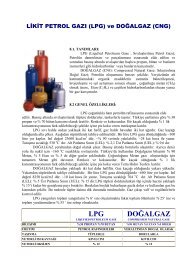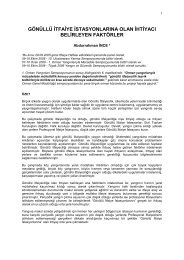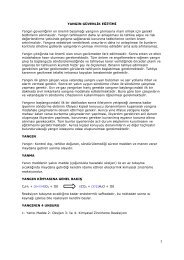buradan - Yangın
buradan - Yangın
buradan - Yangın
You also want an ePaper? Increase the reach of your titles
YUMPU automatically turns print PDFs into web optimized ePapers that Google loves.
inspection and scheduled maintenances is not followed, thus it is<br />
crucial that we all put our efforts to promote a continuous attention<br />
to the general safety requirements – as said in the beginning of the<br />
document, to prevent is, in the most of the occasions, better then to<br />
fix the damage (whereas the damage is fixable). Local rules, local<br />
laws and international standards are setting the minimal safety<br />
requirements in the majority of the modern life ambient. No doubt<br />
that reliability is directly linked to safety. As an example I invite the<br />
reader to think briefly on the cars, an example that suits perfectly<br />
to the intention of this paragraph. Do you remember the cars of<br />
the 70s or the 80s? Well, we are not thinking of prehistory, just<br />
a couple of decades ago, but if you think of ABS, airbags, third<br />
break lights, safety belts and headrest.......was your car equipped<br />
with these optionals ? Most of the answers will be “no”, and an<br />
immediate question will get to your mind: “What has happened to<br />
make such changes/improvements?”. The answer on this question<br />
is: “The sensibility of people”; we are substantially more sensible to<br />
disasters then we used to be. And what about insurance premiums,<br />
if you want to sign a contract for your car you will get a rate if you<br />
don’t have an alarm, another rate if you have a standard alarm<br />
and another if you have a satellite alarm system, the rate changes<br />
depending on the risk, hence on the reliability of your installed<br />
system. Same happens for your fire insurance who knows where<br />
to accept risks and where not.<br />
4. Third Parties<br />
How can we make sure we surround ourselves of quality products,<br />
reliable products? What is the tool we have as purchasers in<br />
everything we buy/rent? The answer is that we should look for<br />
quality assurance proofs. And the proof is most likely an approval<br />
against determined rules, directives, norms and laws given by a<br />
third party that has credibility and is recognized by the authority<br />
having jurisdiction.<br />
Third party approved<br />
Rules compliant<br />
No rules<br />
QUALITY RISK<br />
Figure 4. How third parties work for excellence.<br />
Third parties are companies that have grown since the “Quality”<br />
management system has been adopted and applied, firstly with<br />
Japan and USA who pioneered an equivalence in rules between the<br />
trading and manufacturing companies, and subsequently worldwide.<br />
They had their major development with the standardization of the<br />
manufacturing companies production and management systems<br />
setting the rules, and later on they have been growing on the shove<br />
of countries and associations directives. We frequently hear the<br />
term “approved” or “listed”, a potential definition of these terms<br />
could be: Equipment included in a list published by an organization<br />
acceptable to the “Authority Having Jurisdiction” and concerned<br />
with product evaluation, that maintains periodic inspection of<br />
production of listed equipment and whose listing states that the<br />
equipment meets appropriate standards or has been tested and<br />
found suitable for use in a specified manner.<br />
The third parties are generally trusted companies as they do not<br />
have direct or indirect interests in certifying a certain product or<br />
BİLDİRİLER KİTABI TÜYAK<br />
PROCEEDINGS BOOK 2009<br />
a certain company, if you comply with the requirements you will<br />
get the approval, the certificate, the stamp; on the other hand if<br />
you do not comply you will not get it. Beside of the verification of<br />
a product they are also consultants who can help you in bringing<br />
the processes and the products to the highest standards of safety<br />
and quality. Most of these organizations have world wide network<br />
of offices and partners updating constantly the state of the art on<br />
a specific matter, or product group. Third parties also collaborate<br />
to draw international standards using highly specialized engineers.<br />
Before giving an approval a verification of the analytic design, a<br />
series of testing on the products, audits to the company supply<br />
chain and production process, audits on the testing laboratory of<br />
the applicant are performed. Once the certification is released,<br />
scheduled inspections on the overall quality system of the company<br />
are performed as well and it’s compliance with set production and<br />
testing protocols verified. The third parties are also the connection<br />
between the part producer, it’s installer, the owner and the user,<br />
collaboration between all the mentioned is brought to a single<br />
discussion table where most likely we will find a seat for a regulatory<br />
authority representative.<br />
5. Conclusion<br />
In conclusion we all understand the importance of having a reliable<br />
product to protect our lives before our property, and being a quality<br />
product we need a proof that all the components, the manufacturing<br />
process, the installation process, the testing process meet the<br />
expected lever of reliability of a fire suppression equipment. We<br />
also understand that the complete system in order to work properly<br />
needs to be the most reliable possible:<br />
w Pumps<br />
w Drivers<br />
w Controllers<br />
w Alarms<br />
w Detection systems<br />
w Pipes<br />
w Valves<br />
w Sprinklers<br />
w Extinguishers<br />
w Hoses<br />
All the above need to be ready to do their duty the only time in<br />
their life they are required to, and failure is not an acceptable<br />
option........<br />
6. References<br />
[1]. NFPA20 – 2007 Ed.<br />
[2]. Fire in the United States 1986-1995, Barry Leonard, Ed 10,<br />
1999<br />
[3]. Fundamentals of Fire Fighter Skills, International Association<br />
of Fire Chiefs, Ed 1, 2001<br />
Curriculum Vitae<br />
Andrea Benvenuti, 1979, Business Development Manager for<br />
Peerless Pump Company, Turin, Italy.<br />
TÜYAK 2009<br />
5





